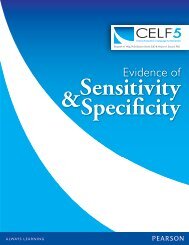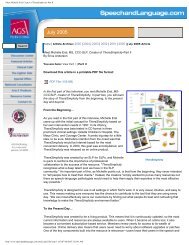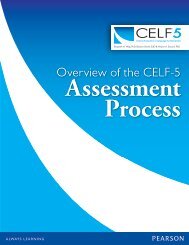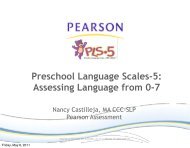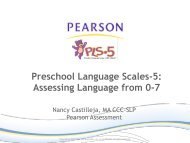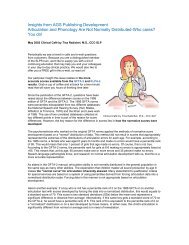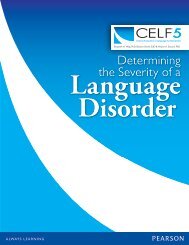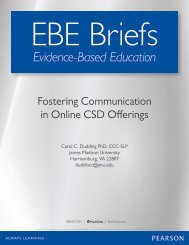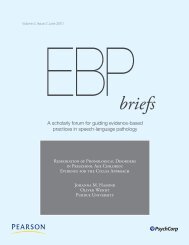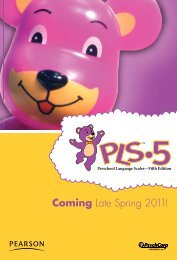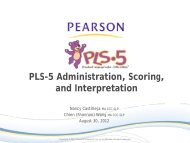EBP Brief V1 Issue 1 [8x10].indd - Speech and Language
EBP Brief V1 Issue 1 [8x10].indd - Speech and Language
EBP Brief V1 Issue 1 [8x10].indd - Speech and Language
You also want an ePaper? Increase the reach of your titles
YUMPU automatically turns print PDFs into web optimized ePapers that Google loves.
Volume 1 Number 1 April 2006<strong>EBP</strong> briefsA scholarly forum for guiding evidence-basedpractices in speech-language pathologyClassroom-Based versus Pull-Out Interventions:A Review of the Experimental EvidenceAnita S. McGinty & Laura JusticeUniversity of VirginiaA publication of AGS Publishing, now part of Pearson Assessments
<strong>EBP</strong> <strong>Brief</strong>sA publication of AGS Publishing, now part of Pearson AssessementsEditorLaura M. JusticeUniversity of VirginiaEditorial Review BoardFrank BenderPrivate PracticeBertha ClarkMiddle Tennessee State UniversityGayle DalyLongwood UniversityDonna GeffnerSt. John’s UniversityJoan KaderavekUniversity of ToledoJudy MontgomeryChapman UniversityBarbara Moore-BrownAnaheim Union High School DistrictSheila WardDetroit Public SchoolsManaging DirectorTina EichstadtPearson Assessments5601 Green Valley DriveBloomington, MN 55437Cite this document as:McGinty, A. S., & Justice, L. M.(2006). Classroom-based versus pulloutspeech-language intervention:A review of the experimental evidence.<strong>EBP</strong> <strong>Brief</strong>s, 1(1), 1-25.i
<strong>EBP</strong> <strong>Brief</strong>sVolume 1 Number 1 April 2006Classroom-Based versus Pull-Out Interventions:A Review of the Experimental EvidenceAnita S. McGinty & Laura JusticeUniversity of Virginiaii
Copyright © 2006 NCS Pearson, Inc. All rights reserved.iii
Introduction 1<strong>EBP</strong> <strong>Brief</strong>s: An IntroductionLaura Justice, EditorI am pleased to introduce an exciting <strong>and</strong> innovative venturesupported by AGS Publishing, now part of Pearson Assessments: <strong>EBP</strong> <strong>Brief</strong>s.<strong>EBP</strong> <strong>Brief</strong>s come at an exciting time in our profession: As speech-languagepathologists are well aware, there is currently a strong emphasis on the need tocritically examine the best available current scientific evidence <strong>and</strong> integratethis evidence with other types of data to arrive at the best solutions to clinicalquestions. In this regard, clinical professionals are asked to bridge the “researchto practice gap” by conducting reviews of the empirical literature in search ofobjective answers to questions faced in the field; subsequent to such review,they are expected to incorporate the resultant empirical evidence into theirdecision-making frameworks. This movement in speech-language pathology isnot occurring in a vacuum; rather, it reflects a more general paradigm shift inthe medical, allied health, <strong>and</strong> educational disciplines in which professionalsare asked to consult the scientific evidence in their everyday decision-making,to ensure that theory <strong>and</strong> craft are balanced with data <strong>and</strong> evidence.Evidence-based practice (<strong>EBP</strong>) is the term that describes the processclinical professionals go through as they consult various types of informationto answer a clinical question. In the process of reviewing relevant informationsources, the scientific literature is but one source consulted, but the tenets of<strong>EBP</strong> position this literature to be just as relevant as other information sourcesthat are typically consulted (e.g., clinical experience, theoretical perspective).The clinician engaged in the process of <strong>EBP</strong> arrives at an answer to a clinicalquestion that integrates information from an array of inputs, to includenot only the scientific literature but also examination of client preferences,institutional norms <strong>and</strong> policies, <strong>and</strong> his/her theoretical knowledge <strong>and</strong>clinical experiences.For clinicians to engage in the <strong>EBP</strong> process, they must have accessto not only high-quality research studies relevant to the clinical questionsthey ask, but also to systematic reviews of particular bodies of evidence thatattempt to find objective answers to commonly-asked questions. <strong>EBP</strong> <strong>Brief</strong>sis designed to support evidence-minded professionals by identifying <strong>and</strong>answering clinically-relevant questions using current st<strong>and</strong>ards of evidence-
2 <strong>EBP</strong> <strong>Brief</strong>sbased practice, with a particular focus on examining evidence relevant topressing questions in school-based practice. Each brief considers a specificquestion, evaluates the available scientific evidence relevant to this question,<strong>and</strong> makes recommendations for integrating this scientific evidence into clinicaldecision-making.<strong>EBP</strong> <strong>Brief</strong>s will be published in electronic format on a quarterly basis,<strong>and</strong> in a hard-copy journal format annually. Forthcoming briefs to look forwardto in this 2006 inaugural volume include examinations of approaches usedto address children’s needs in social communication, vocabulary, fluency, <strong>and</strong>phonology. In planning for our second volume in 2007, I invite professionalsto contact me to identify specific questions they encounter in clinical practicewhich we ought to systematically explore in <strong>EBP</strong> <strong>Brief</strong>s.ljustice@virginia.edu
Classroom-Based versus Pull-Out <strong>Language</strong> Intervention:An Examination of the Experimental EvidenceAnita S. McGintyLaura M. JusticeUniversity of VirginiaThis brief examinesthe research evidencesupporting pull-out versusclassroom-based modelsof language intervention.In this brief, we consulted the available experimental evidence toconsider an important question that clinicians often ask: Should I providespeech-language intervention within the child’s classroom (classroom-based)or outside of the classroom (pull-out)? Following the tenets of evidence-basedpractice, we posed this question following the PICO framework (Centre forEvidence Based Medicine, 2001; Sackett, Straus, Richardson, Rosenberg, &Haynes, 1996), in which P represents the Patient, Patient Group, Population, orProblem; I represents the Intervention under consideration;C represents the Comparison intervention (i.e., either thest<strong>and</strong>ard approach or no intervention); <strong>and</strong> O representsthe desired Outcome. Thus, our <strong>EBP</strong> question was this:Would a preschool or early-elementary child with languageimpairment (P) show greater improvement with classroombasedlanguage intervention (individual or group) (I) or pull-out intervention(individual or group) (C), as shown by improvements in language skills in theareas of phonology, morphology/syntax, pragmatics, <strong>and</strong>/or vocabulary (O)?Background <strong>and</strong> RationaleWhen providing interventions to children with language impairment(LI) in the context of schooling, speech-language pathologists (SLPs) needto not only identify specific therapeutic targets <strong>and</strong> approaches, but also theintervention context or model of service delivery. Two general contexts/modelsprevail: pull-out <strong>and</strong> classroom-based. In pull-out models, the speech-languagepathologist typically works with individual or small groups of children withcommunicative impairments in a workspace designated for this purpose.
4 <strong>EBP</strong> <strong>Brief</strong>sOccasionally, peers without disabilities may participate in small-group activitiesto provide peer models during intervention. By contrast, classroom-basedintervention is delivered within the classrooms of children with communicativeimpairments. Classroom-based models include several different approaches,typically differentiated into indirect <strong>and</strong> direct service delivery models basedon the role of the SLP. With indirect services, the SLP serves as a consultantto the classroom teacher, providing expert guidance on adjusting targets <strong>and</strong>approaches to meet the needs of pupils with speech-language impairmentswithin the classroom setting. With direct services, the SLP collaborates withthe classroom teacher using a team-teaching approach (Meyer, 1997), or,alternatively, may deliver language lessons on his/her own to the class as awhole.Relative to pull-out models, classroom-based interventions are oftenviewed as adhering to a more inclusive philosophy of education for childrenwith disabilities. Inclusion is a philosophy that advocates education of pupilswith disabilities in the same contexts of non-disabled peers (Meyer, 1997). Bycontrast, pull-out interventions are seen as non-inclusive, in that children withdisabilities are removed from general education to receive intervention awayfrom their peers. The possible value of classroom-based models of interventiongoes beyond philosophy, however, <strong>and</strong> are viewed by some experts as likely moreeffective than pull-out models, particularly in the area of skill generalization.Classroom-based approaches may enhance skill generalization through theiremphasis on naturalistic routines <strong>and</strong> materials, the involvement of peers asboth conversational models <strong>and</strong> partners, <strong>and</strong> the involvement of teacherswho can extend language instruction throughout the day (Wilcox, Kouri, &Caswell, 1991).Historically, speech-language interventions often used pull-out modelsfeaturing individual or small-group treatment. Since 1975, however, changes infederal law as well as general philosophies towards the education <strong>and</strong> treatmentof children with disabilities has motivated SLPs to consider more inclusiveapproaches to intervention (Ehren, 2000; Elksnin & Capilouto, 1994; Kavale,2002; Manset & Semmel, 1997), including delivery of interventions directlywithin the general education classroom (Beck & Dennis, 1997; Ehren, 2000;
Classroom-Based versus Pull-Out <strong>Language</strong> Intervention 5Westby, 1994). As innocuous as classroom-based models of service deliverymay seem, use of this service delivery model is not without controversy (Beck& Dennis, 1997; Ehren, 2000; Kavale, 2002; Westby, 1994); researchers havereported concerns about the overall effectiveness of classroom-based services(Ehren, 2000; Elksnin & Capilouto, 1994), challenges in collaborative teaming(Achilles, Yates, & Freese, 1991; Beck & Dennis, 1997; Russell & Kaderavek,1993) <strong>and</strong> concerns regarding the unilateral application of inclusive philosophieswithout regard to individual differences (Westby, 1994). Such concerns weresummarized in a statement by the American <strong>Speech</strong> <strong>and</strong> Hearing Association(ASHA) warning that “the shift toward inclusion will not be optimal whenimplemented in absolute terms...the unique <strong>and</strong> specific needs of each child<strong>and</strong> family must always be considered” (1996, p. 1).Within an <strong>EBP</strong> framework, clinicians make decisions about the contextin which to provide school-based language interventions following the sameprocess used when making choices related to other aspects of interventionprogramming, such as goal selection <strong>and</strong> sequencing, progress monitoring,<strong>and</strong> length <strong>and</strong> intensity of therapy. In making decisions regarding treatmentcontexts, SLPs who adhere to the tenets of <strong>EBP</strong> considerEvidence-based practice requirestheir theories <strong>and</strong> experiences with various contextsSLPs to consider their theories,of service delivery, the specific needs of children <strong>and</strong>experiences, the specific needsof clients, <strong>and</strong> the accumulatedfamilies, as well as the overall culture <strong>and</strong> norms of thescientific literature when making schools in which they work; additionally, they also lookclinical decisionsto the accumulated scientific literature for objectiveguidance concerning the effectiveness of treatmentwithin different contexts (i.e., classroom-based vs. pull-out).Of particular relevance to the SLP considering which service deliverycontext to use with a particular child are experimental studies that havecompared treatment outcomes for classroom-based versus pull-out models.Although a variety of research designs can provide important evidence to drawupon in clinical decision-making (e.g., see Horner, Carr, Halle, McGee, Odom,& Wolery, 2005; Thompson, Diamond, McWilliam, Snyder, & Snyder, 2005),the most rigorous design is that of the experimental study, which is designedspecifically to establish causality (Law, Garrett, & Nye, 2005). Accordingly,
6 <strong>EBP</strong> <strong>Brief</strong>smany organizations that oversee development of systematic reviews thatsynthesize the evidence on a particular intervention privilege experimentalstudies (particularly r<strong>and</strong>omized clinical trials) as providing the strongest typeof evidence, when the study is of sufficient quality (What Works Clearinghouse,2005).A number of experimental or quasi-experimental studies have directlyinvestigated the impact of classroom-based interventions on children’s languageoutcomes, but relatively few of these have directly compared children’s outcomesfor classroom-based models relative to pull-out models of intervention. In thisreview, in which our goal was to synthesize the available scientific evidencerelevant to the question of whether clinicians ought to use classroom-based orpull-out language interventions, we focused specifically on those studies thatdirectly compared these two models of service delivery.MethodInclusionary/Exclusionary CriteriaPrior to searching for studies relevant to our clinical question, wedeveloped a set of inclusionary/exclusionary criteria (see Table 1) for identifyingstudies to be included in this review. Our first criterion was that the studyfeatured an experimental design (r<strong>and</strong>omized clinical trial; RCT), quasiexperimentaldesign (QED), or regression discontinuity design (RD), as thesethree types of designs provide the best evidence of causality (Gersten, Fuchs,Compton, Coyne, Greenwood, & Innocenti, 2005). The U.S. Departmentof Education’s What Works Clearinghouse (www.whatworks.ed.gov), whichpublishes systematic reviews of research to identify educational interventionswith sufficient evidence to support their use, considers only evidence fromstudies using these three designs in their reviews. In these designs, the focus ofinvestigation is estimating the causal relationship between a set of independentvariable(s) <strong>and</strong> a set of dependent/outcome variable(s). To be included in thepresent review, the independent variable(s) needed to represent a comparison ofclassroom-based versus pull-out models of language intervention, whereas thedependent measures needed to represent child language outcomes in expressive<strong>and</strong>/or receptive language (phonology, vocabulary, syntax/morphology, <strong>and</strong>/or
Classroom-Based versus Pull-Out <strong>Language</strong> Intervention 7pragmatics).Additional criteria for inclusion of studies specified participants’ agerange (two to eight years) <strong>and</strong> type of disability; for the latter, we includedstudies involving children with specific language impairment (SLI; receptive<strong>and</strong>/or expressive) <strong>and</strong> excluded studies involving children with languageimpairment secondary to cognitive <strong>and</strong> sensory disabilities (e.g., mentalretardation, autism), similar to Law et al. (2004). As much as 6 to 8% ofyoung children exhibit SLI (Tomblin et al., 1997), <strong>and</strong> with its clear impact onboth early <strong>and</strong> later academic achievement (Aram, Ekelman, & Nation, 1984;Scarborough & Dobrich, 1990), it is one of the most common disabilitiesaddressed by special educators working in the public schools. Final criteria forstudy inclusion concerned publication venue, to include only English-languagestudies published in peer-reviewed journals.Article SearchA comprehensive search protocol was developed to identify studiesmeeting the inclusionary criteria identified previously. Databases searchedincluded PsychINFO; Educational Resources Information Center (ERIC);Campbell Collaboration Social, Psychological, Education, <strong>and</strong> CriminologicalTrials Register; Cochrane Controlled Trials Register; American <strong>Speech</strong>-<strong>Language</strong>-Hearing Association Journal Archives; What Works Clearinghouse;<strong>and</strong> the Scottish Intercollegiate Guidelines Network.Three experimental studies Additionally, Law <strong>and</strong> colleague’s (2004) recent meta-analysis ofdirectly compared childspeech-language treatment efficacy was also examined. A totaloutcomes in classroom-basedof 783 papers were screened for inclusion, <strong>and</strong> of these, 34 wereversus pull-out models oflanguage intervention.identified for further examination of the full-text article. Of these34 articles, 23 were eliminated because they did not use an RCT,RD, or QED design; five because they did not directly compareclassroom-based vs. pull-out intervention; <strong>and</strong> three because the study sampledid not reflect our inclusionary criteria. Therefore, the final corpus available forthis review was three studies. This figure, while low, is not surprising given thatLaw <strong>and</strong> colleagues (2004) found only 13 studies for their systematic reviewof treatment outcomes for children with SLI receiving any type of language
8 <strong>EBP</strong> <strong>Brief</strong>sintervention.In Appendix 1, we provide a description of articles that surfaced inour review that provided comparisons of various service delivery models <strong>and</strong>contexts for children with a range of abilities/disabilities; readers can consultthese works for additional guidance in their evidence-based decision-makingconcerning treatment contexts. Table 2 presents a summary of the three studiesincluded in the present review.ResultsDescription of Included StudiesThe three studies included in this review (see Table 2) involved a totalsample size of 91 children with SLI: 20 between the ages of 20 to 47 months(Wilcox et al., 1991), 39 between 3 <strong>and</strong> 5 years (Valdez & Montgomery,1997), <strong>and</strong> 31 in kindergarten through third grade (Throneburg, Calvert,Sturm, Paramboukas, & Paul, 2000). Fifty-three children received languageintervention in a classroom-based inclusive setting using a team-teachingcollaborative model (n = 42) or SLP-lead inclusive instruction with the SLPworking independently of the classroom teacher (n = 11). Thirty-eight childrenreceived pull-out intervention in individual or small-group sessions. Theduration of intervention ranged from three months to six months, <strong>and</strong> childrentypically received one or two treatment sessions weekly. Outcome measures intwo studies focused specifically on vocabulary, documenting children’s growthin vocabulary using an experimenter-developed test (Throneburg et al., 2000)or language sample analysis (Wilcox et al., 1991); one study used a normreferencedst<strong>and</strong>ardized test of language as the primary outcome measure(Valdez & Montgomery, 1997).Quality of EvidenceAs Law <strong>and</strong> colleagues (2004) point out, experimental studies varytremendously in the quality of their design. For descriptive purposes, weconducted a quality assessment of the three studies included in this review,focusing on 11 attributes of high-quality studies using Law et al.’s 3-point scale(0=inadequate, 1=unclear, 2=adequate), as presented in Table 3. Appendix
Classroom-Based versus Pull-Out <strong>Language</strong> Intervention 92 provides a description of each attribute evaluated; the 11 attributes wereselected from available descriptions of high-quality indicators of experimental<strong>and</strong> quasi-experimental research. Each of the authors independently scoredeach of the three studies for these 11 attributes; scores were compared toestablish inter-rater reliability of the scoring protocol, which was 90%.There is currently little agreement on what differentiates higher <strong>and</strong> lowerquality studies, although studies of higher quality provide the most rigoroustest of causality for the intervention under investigation. The What WorksClearinghouse st<strong>and</strong>ards of evidence for establishing causality of an interventionrequire RCTs to use r<strong>and</strong>omization, ensure baseline equivalence, <strong>and</strong> addressattrition, each of which was rated as adequate for the two RCTs included inthis review. Quasi-experimental designs that ensure baseline equivalence <strong>and</strong>address attrition can meet evidence st<strong>and</strong>ards, albeit with reservations given thatcausality is less certain due to lack of r<strong>and</strong>omization. The single QED includedin this review was rated as adequate on these attributes. Thus, in terms of designquality, the three studies included in this review were of sufficient quality toestablish causal relationships between intervention contexts (classroom-basedvs. pull-out) <strong>and</strong> children’s language outcomes.Estimated Effects: Classroom-Based <strong>and</strong> Pull-Out InterventionTable 4 summarizes study outcomes based on the authors’ descriptions;we also present our own calculation of effect-size estimates (st<strong>and</strong>ardizedposttest differences, corrected for bias using Hedges <strong>and</strong> Olkin’s factor, 1985)with 95% confidence intervals based on posttest data from the study reports.Per Cohen (1988), we considered an effect-size estimate (d) of 0.2 as small,0.5 as medium, <strong>and</strong> 0.8 as large. Effect-size estimates represent the differencein scores between two groups using st<strong>and</strong>ard deviation units; thus, an effectsizeof d = 0.95 calculated on the posttest scores between two groups suggeststhat one group’s posttest scores were nearly one st<strong>and</strong>ard deviation higherthan those of the other group, consistent with a large intervention effect. Notethat effect size estimates could not be calculated for Valdez <strong>and</strong> Montgomery(1997), as the report did not include st<strong>and</strong>ard deviations for children’s posttestdata. Considering both the authors’ own analyses of child outcomes <strong>and</strong> our
10 <strong>EBP</strong> <strong>Brief</strong>scalculations of effect-size estimates on posttest data, two studies (Throneburg etal., 2000; Wilcox et al., 1991) show better outcomes for children in classroombasedinterventions that involve team-teaching in inclusive classrooms (i.e.,classrooms containing peers without disabilities), whereas one study reports nodifferences in child outcomes when comparing classroom-based <strong>and</strong> pull-outconditions (Valdez & Montgomery, 1997).Examining the findings from the three studies more closely, Throneburget al. (2000) reported that children in the collaboration condition, in whichSLPs team-taught language lessons with the classroom teachers, exhibitedgreater gains in curricular vocabulary compared to children in a classroombasedcondition in which SLPs taught alone (d = 1.56, CI =0.63-2.5) <strong>and</strong> children in a pull-out condition (d = 0.31, CI Throneburg <strong>and</strong> colleagues= -0.56-1.18). The difference between posttest vocabulary found classroom-based teamteachingto be more effective forscores for children in the team-taught classroom-basedintervention <strong>and</strong> the SLP-alone classroom-based intervention improving children’s curricularwas very large when considering effect-size estimates. And, vocabulary knowledge thanpull-out intervention.although the difference in curricular vocabulary outcomesfor children in the classroom-based <strong>and</strong> pull-out conditionswas not statistically significant, based on the authors’ inferential test statistics,our calculation of effect-size estimates suggested a clear advantage for pull-outover classroom-based intervention in which the SLP taught alone (d = -0.76,CI = -1.67-0.15).Like Throneburg <strong>and</strong> colleagues, Wilcox et al. (1991) found asignificant difference in children’s productive vocabulary use, particularly whenconsidering children’s vocabulary use in the home setting, for classroom-basedteam-teaching (SLP + special educator) compared to a pull-out condition (d= 0.81, CI = -0.1-1.72). Again, the effect-size estimate on posttest scores wasconsistent with a large effect.Valdez <strong>and</strong> Montgomery’s findings diverged from the previous twostudies reviewed, showing no difference in classroom-based <strong>and</strong> pull-outconditions for children’s total language <strong>and</strong> expressive language scores butreporting an advantage for the pull-out condition on children’s receptivelanguage. It is difficult to assess, however, the strength of causal interpretations
Classroom-Based versus Pull-Out <strong>Language</strong> Intervention 11for Valdez <strong>and</strong> Montgomery (1997), as the report does not provide teststatistics for comparisons of children’s performance at posttest, nor are st<strong>and</strong>arddeviations included in their descriptive tables for our own calculation of posttesteffect-size estimates. We therefore were unable to calculate effect-size estimateson posttest differences between the two groups. As a result, we consideredThroneburg et al. (2000) <strong>and</strong> Wilcox et al. (1991) to provide the strongestcausal interpretations regarding child language outcomes in the two servicedelivery contexts (classroom-based vs. pull-out): both showed an advantage forvocabulary development in classroom-based inclusive team-teaching approachescompared to pull-out instruction, with effect-size estimates consistent withlarge to very large differences favoring classroom-based models.ConclusionsWould a preschool or early-elementary child with language impairment(P) show greater improvement with classroom-based language intervention(individual or group) (I) or pull-out intervention (individual or group) (C),as shown by improvements in language skills in the areas of phonology,morphology/syntax, pragmatics, <strong>and</strong> or vocabulary (O)?Scientific inquiry is, ultimately, about accumulating evidence <strong>and</strong>establishing convergence of findings across studies. As clinical professionals, weought not to change practices in light of evidence from one study; nonetheless,when several well-conducted studies converge in their findings, it does suggestthat evidence from these studies ought to warrant careful consideration inevidence-based decision-making.As we reported in this review of three studies comparing pull-out<strong>and</strong> classroom-based models of language intervention, two of three studiesconverged in their findings of a benefit to collaborative classroom-basedservices over pull-out services for preschool <strong>and</strong> early elementary pupils whenaddressing vocabulary goals. In interpreting the divergent findings from thethird study, Valdez <strong>and</strong> Montgomery (1997), considerations regarding themodel of classroom-based intervention <strong>and</strong> the means of measuring outcomesprovide possible explanations for their difference in findings. Throneburg etal. (2000) <strong>and</strong> Wilcox et al. (1991) used a team-teaching approach in their
12 <strong>EBP</strong> <strong>Brief</strong>sclassroom-based models, in which the SLP <strong>and</strong> special educator worked sideby-side;in Valdez <strong>and</strong> Montgomery (1997), however, the description of theclassroom-based condition was not sufficient for determining if the classroombasedapproach involved a team teaching approach or SLP-lead instructionoccurring separately from teacher-lead instruction. As Throneburg et al. (2000)showed, these two types of classroom-based service delivery models differed intheir effects on children’s language outcomes; in fact, Throneburg et al. foundSLP-lead lessons (occurring in absence of the classroom teacher) was lesseffective than pull-out models <strong>and</strong> a team-teaching classroom-based approach.An additional point for consideration is that Valdez <strong>and</strong> Montgomery’s(1997) outcome measure was a st<strong>and</strong>ardized test of general language, whichmay not have been well aligned or sensitive to changes in children’s languageachievements during intervention; by comparison, both Throneburg et al.(2000) <strong>and</strong> Wilcox et al. (1991) used outcome measures carefully aligned tomeasuring aspects of language targeted in intervention. Taken together, theconvergent findings from Throneburg et al. (2000) <strong>and</strong> Wilcox et al. (1991)suggested an advantage for classroom-based team-teaching models over pulloutintervention, at least in the domain of vocabulary.Limitations in the number of studies included in this review, thestrength of effect-size estimates, <strong>and</strong> weaknesses in study quality require thatthese review findings are interpreted cautiously. The fact that only three studieswere able to meet design-based evidence st<strong>and</strong>ards for inclusion in this reviewhighlights the clear dearth of evidence regarding various service-delivery models,<strong>and</strong> the lack of a clear effect for classroom-based over pull-out intervention inone of the three studies suggests the need for future, rigorous evaluations ofclassroom-based models of therapy for more conclusive answers. Additionally,while medium to large effect sizes were found in Throneburg et al. (2000) <strong>and</strong>Wilcox et al. (1991) for collaborative team-teaching in comparison to pull-outtherapy, the 95% confidence intervals for some estimates included 0, raisingthe possibility that neither approach (classroom-based vs. pull-out) providedan advantage in children’s vocabulary outcomes. Finally, weaknesses in thestudies pose potential threats to the strengths of the studies’ findings. Noneof the studies used assessors who were blind to treatment conditions, which
Classroom-Based versus Pull-Out <strong>Language</strong> Intervention 13potentially allows for a bias on the part of the assessor to impact results. OnlyWilcox et al. (1991) provided information on fidelity to treatment <strong>and</strong> onlyValdez <strong>and</strong> Montgomery (1997) provided sufficient information regardingthe use of equivalent service providers across conditions, raising questions as towhether outcomes were also impacted by the process of service delivery <strong>and</strong>/orcharacteristics of the treatment providers. Future studies that compare variousservice-delivery options must include more rigorous design features, includingblind assessors. As a final limitation, we also note that with only three studiesserving as our corpus for review, it is not clear that results can be generalized.As each of the three studies involved children from a single geographic region,from primarily one race (either Caucasian or African American), <strong>and</strong> fromlower to middle socioeconomic backgrounds, large scale effectiveness studiesshould investigate the impact of these treatment models on socially, ethnically<strong>and</strong> geographically diverse population to improve generalization of findings.In sum, this review considered three experimental studies comparingchild language outcomes for two prevalent service-delivery contexts: classroombased<strong>and</strong> pull-out. Systematic review of the outcomes showed an advantagefor classroom-based inclusive models in which the SLP <strong>and</strong> classroom teacherteam-taught language lessons. With the framework of evidence-based practice,clinicians can integrate the evidence presented in this review with other sourcesof information, such as child <strong>and</strong> family preferences, their own experienceswith various models of service delivery, <strong>and</strong> the culture in which they work, tomake the best decisions concerning the models of service delivery they use tomeet the needs of the children with whom they work.ReferencesAchilles, J., Yates, R. R., & Freese, J. M. (1991). Perspectives from the field:Collaborative consultation in the speech <strong>and</strong> language program of theDallas Independent School District. <strong>Language</strong>, <strong>Speech</strong>, <strong>and</strong> HearingServices in Schools, 22, 154-155.American <strong>Speech</strong>-<strong>Language</strong>-Hearing Association (1996, Spring). Inclusivepractices for children <strong>and</strong> youths with communication disorders:Position statement <strong>and</strong> technical report. Asha, 38 (Suppl. 16), 35-44.
14 <strong>EBP</strong> <strong>Brief</strong>sAram, D. M., Ekelman, B. L., & Nation, J. E. (1984). Preschoolers withlanguage disorders: 10 years later. Journal of <strong>Speech</strong> <strong>and</strong> HearingResearch, 27, 232-244.Beck, A. R., & Dennis, M. (1997). <strong>Speech</strong>-language pathologists’ <strong>and</strong>teachers’ perceptions of classroom-based interventions. <strong>Language</strong>,<strong>Speech</strong>, <strong>and</strong> Hearing Services in Schools, 28, 146-153.Centre for Evidence Based Medicine (2001). Levels of evidence <strong>and</strong> gradesof recommendation. Available at http://www.cebm.net/levels_of_evidence.asp.Cohen, J. (1988). Statistical power analysis for the behavioral sciences (2nd ed.).Hillsdale, NJ: Erlbaum.Cole, K. N., Mills, P. E., Dale, P. S., & Jenkins, J. R. (1996). Preschoollanguage facilitation methods <strong>and</strong> child characteristics. Journal ofEarly Intervention, 20(2), 113-131.Ehren, B. J. (2000). Maintaining a therapeutic focus <strong>and</strong> sharingresponsibility for student success: Keys to in-classroom speechlanguageservices. <strong>Language</strong>, <strong>Speech</strong>, <strong>and</strong> Hearing Services in Schools,31, 219-229.Elksnin, L. K., & Capilouto, G. J. (1994). <strong>Speech</strong>-language pathologists’perceptions of integrated service delivery in school settings. <strong>Language</strong>,<strong>Speech</strong>, <strong>and</strong> Hearing Services in Schools, 25, 258-267.Ellis, L., Schlaudecker, C., & Regimbal, C. (1995). Effectiveness of acollaborative consultation approach to basic concept instructionwith kindergarten children. <strong>Language</strong>, <strong>Speech</strong>, <strong>and</strong> Hearing Services inSchools, 26, 69-73.
Classroom-Based versus Pull-Out <strong>Language</strong> Intervention 15Farber, B. A., & Klein, E. R. (1999). Classroom-based assessment of acollaborative intervention program with kindergarten <strong>and</strong> first-gradestudents. <strong>Language</strong>, <strong>Speech</strong>, <strong>and</strong> Hearing Services in Schools, 30, 83-91.Gersten, R., Fuchs, L. S., Compton, D., Coyne, M., Greenwood, C., &Innocenti, M. S. (2005). Quality indicators for group experimental<strong>and</strong> quasi-experimental research. Exceptional Children, 71, 137-149.Hedges, L. V., & Olkin, I. (1985). Statistical methods for meta-analysis.Orl<strong>and</strong>o, FL: Academic Press.Horner, R. H., Carr, E. G., Halle, J., McGee, G., Odom, S. L., & Wolery,M. (2005). The use of single-subject research to identify evidencebasedpractice in special education. Exceptional Children, 71(2), 165-179.Kavale, K. A. (2002). Mainstreaming to full inclusion: from orthogenesisto pathogenesis of an idea. International Journal of Disability,Development <strong>and</strong> Education, 49(2), 201-214.Law, J., Garrett, Z., & Nye, C. (2005). The efficacy of treatment for childrenwith developmental speech <strong>and</strong> language delay/disorder: A metaanalysis.Journal of <strong>Speech</strong>, <strong>Language</strong>, <strong>and</strong> Hearing Research, 47, 924-943.Manset, G., & Semmel, M. I. (1997). Are inclusive programs for studentswith mild disabilities effective? A comparative review of modelprograms. The Journal of Special Education, 31, 155-180.Meyer, J. (1997). Models of service delivery. In P. O’Connel (Ed.), <strong>Speech</strong>,language, <strong>and</strong> hearing programs in schools: A guide for students <strong>and</strong>practitioners. Gaithersburg, MD: Aspen Publishers.
16 <strong>EBP</strong> <strong>Brief</strong>sRafferty, Y., Piscitelli, V., & Boettcher, C. (2003). The impact of inclusionon language development <strong>and</strong> social competence among preschoolerswith disabilities. Exceptional Children, 4, 467-479.Roberts, J. E., Prizant, B., & McWilliam, R. A. (1995). Out-of classversus in-class service delivery in language intervention: Effects oncommunication interactions with young children. American Journal of<strong>Speech</strong>-<strong>Language</strong> Pathology, 69(4), 87-94.Russell, S. C., & Kaderavek, J. (1993). Alternative models for collaboration.<strong>Language</strong>, <strong>Speech</strong>, <strong>and</strong> Hearing Services in Schools, 24, 76-78.Sackett, D.L., Straus, S.E., Richardson, W.S., Rosenberg, W., & Haynes,R.B. (2000). Evidence-based medicine: How to practice <strong>and</strong> teach EBM.Edinburgh: Churchill Livingstone.Scarborough, H. S., & Dobrich, W. (1990). Development of children withearly language delay. Journal of <strong>Speech</strong> <strong>and</strong> Hearing Research, 33, 70-83.Thompson, B., Diamond, K. E., McWilliam, R., Snyder, P., & Snyder, S. W.(2005). Evaluating the quality of evidence from correlational researchfor evidence-based practice. Exceptional Children, 71, 181-194.Throneburg, R. N., Calvert, L. K., Sturm, J. J., Paramboukas, A. A., & Paul,P. J. (2000). A comparison of service delivery models: Effects ofcurricular vocabulary skills in the school setting. American Journal of<strong>Speech</strong>-<strong>Language</strong> Pathology, 9, 10-20.Tomblin, J. B., Records, N. L., Buckwalter, P., Zhang, X., Smith, E., &O’Brien, M. (1997). Prevalence of specific language impairmentin kindergarten children. Journal of <strong>Speech</strong>, <strong>Language</strong>, <strong>and</strong> HearingResearch, 40, 1245-1260.
Classroom-Based versus Pull-Out <strong>Language</strong> Intervention 17Valdez, F. M., & Montgomery, J. K. (1997). Outcomes from two treatmentapproaches for children with communication disorders in Head Start.Journal of Children’s Communication Development, 18, 65-71.Westby, C. E. (1994). The vision of full inclusion: Don’t exclude kids byincluding them. Journal of Childhood Communication Disorders, 16,13-22.What Works Clearinghouse (2005).WWC study review st<strong>and</strong>ards. Available at:http://www.whatworks.ed.gov/reviewprocess/study_st<strong>and</strong>ards_final.pdf.Wilcox, M. J., Kouri, T. A., & Caswell, S. B. (1991). Early languageintervention: A comparison of classroom <strong>and</strong> individual treatment.American Journal of <strong>Speech</strong>-<strong>Language</strong> Pathology, 1, 49-60.Yoder, P. J., Kaiser, A. P., Goldstein, H., Alpert, C., Mousetis, L., Kaczmarek,L., et al. (1995). An exploratory comparison of milieu teaching <strong>and</strong>responsive interaction in classroom applications. Journal of EarlyIntervention, 19(3), 218-242.
18 <strong>EBP</strong> <strong>Brief</strong>sTable 1. Inclusionary <strong>and</strong> Exclusionary Criteria for StudiesDesignR<strong>and</strong>omized Controlled Trial (RCT)ORQuasi-experimental design (QED)ORRegression discontinuity design (RD)Independent Variable(s)Direct comparison of classroom-based <strong>and</strong> pull-out servicesANDIntervention targets expressive <strong>and</strong>/or receptive language skills in phonology, vocabulary,syntax/morphology, <strong>and</strong>/or pragmaticsDependent Variable(s)Direct measures of receptive <strong>and</strong>/or language skills in phonology, vocabulary, syntax/morphology, <strong>and</strong>/or pragmaticsParticipantsChildren between 2 <strong>and</strong> 8 years of ageANDPrimary impairment of language (receptive <strong>and</strong>/or expressive impairment in phonology,vocabulary, syntax/morphology, <strong>and</strong>/or pragmatics)PublicationPeer-reviewed journalANDEnglish language
Classroom-Based versus Pull-Out <strong>Language</strong> Intervention 19Table 2. Description of Studies Comparing Classroom-Based <strong>and</strong> Pull-Out <strong>Language</strong>Intervention.Throneburg, R. N., Calvert, L. K., Sturm, J. J., Paramboukas, A. A., & Paul, P. J. (2000). Acomparison of service delivery models: Effects of curricular vocabulary skills in the school setting.American Journal of <strong>Speech</strong>-<strong>Language</strong> Pathology, 9, 10-20.Participants31 children (primarily Caucasian) in kindergarten through thirdgrade attending 12 classrooms in two elementary schools. An additional146 typically-developing peers in their classrooms participated.Children identified with speech <strong>and</strong> language impairmentbased on st<strong>and</strong>ardized testing by school SLPs. Performance of -1SDof the mean or lower on two tests required for eligibility.Research DesignQuasi-Experimental Design using 12 intact classrooms in threeschools assigned to three conditions (4 classrooms per condition).Eight of 12 classrooms r<strong>and</strong>omly assigned to two conditions(classroom-based, pull-out); remaining four classrooms assigned tocollaborative condition for administrative reasons.Experimental Intervention 1 “Collaborative:” Collaborative team-taught language lessons towhole class by SLP, classroom teacher, <strong>and</strong> two graduate students inweekly 40-min sessions for a 12-week period (8 hours of treatmenttotal) combined within an additional 15-min pull-out small-groupsession.Experimental Intervention 2 “Classroom-Based:” SLP-delivered language lessons to whole classin weekly 40-min sessions for a 12-week period (8 hours of treatmenttotal) combined within an additional 15-min pull-out smallgroupsession.Comparison Intervention “Pull-Out:” Weekly 50-min small-group or individual pull-out sessionsheld in speech room for 12 weeks.Outcome Measure Researcher-developed vocabulary test of curricular vocabulary (onefor each grade level) comprising 20 words, with up to 60 pointspossible.Valdez, F. M., & Montgomery, J. K. (1997). Outcomes from two treatment approaches for childrenwith communication disorders in Head Start. Journal of Children’s Communication Development,18, 65-71.Participants 39 African-American children ranging from 3 to 5 years (M = 3.9years) enrolled in four Head Start centers. Children identified withSLI using st<strong>and</strong>ardized test of language by certified SLPs. (Exactcriteria not specified.)Research DesignR<strong>and</strong>omized Clinical Trial comparing two conditions using ar<strong>and</strong>omized block design with stratification by severity of languageimpairment (mild, moderate, severe).
20 <strong>EBP</strong> <strong>Brief</strong>sTable 2, ContinuedExperimental Intervention “Inclusion Group:” 90-min treatment session weekly for six months(36 hours of treatment total) conducted in Head Start classroomwith 10 to 15 typical peers. Specific approach <strong>and</strong> targets not identified.Comparison Intervention “Pull-Out Group:” 90-min treatment session weekly for six months(36 hours of treatment total) conducted in small groups in a “smallseparate room” at a Head Start center. Neither the size of groups norspecific approaches <strong>and</strong> targets were identified.Outcome Measure St<strong>and</strong>ardized test scores on six subtests of the Clinical Evaluationof <strong>Language</strong> Fundamentals-Preschool (CELF-P; Wiig, Secord, &Semel, 1991): Linguistic Concepts, Basic Concepts, Sentence Structure,Recalling Sentences, Formulating Labels, <strong>and</strong> Word Structure.Total <strong>Language</strong> Score, Receptive <strong>Language</strong> Score, <strong>and</strong> Expressive<strong>Language</strong> Score also reported.Wilcox, M. J., Kouri, T. A., & Caswell, S. B. (1991). Early language intervention: A comparison ofclassroom <strong>and</strong> individual treatment. American Journal of <strong>Speech</strong>-<strong>Language</strong> Pathology, 1, 49-60.Participants 20 children (race/ethnicity unspecified) ranging from 20 to 47months (M = 3.9 years). Children identified with SLI using st<strong>and</strong>ardizedtest of language conducted at a university speech <strong>and</strong> hearingclinic; performance of -1.5 SD of the mean or lower requiredfor eligibility.Research DesignR<strong>and</strong>omized Clinical Trial comparing two conditions.Experimental Intervention “Classroom Intervention:” Twice-weekly treatment sessions for 12-16 weeks conducted in classroom of 12 to 14 children. Interventiondelivered by team (SLP <strong>and</strong> early childhood special educator) usinginteractive modeling of vocabulary targets during regular classroomactivities across a 3-hour period.Comparison Intervention “Individual Intervention:” Twice-weekly 45-min one-on-one treatmentsessions for 12-16 weeks in speech/language room. Interventiondelivered by student SLP using interactive modeling of vocabularytargets.Outcome Measure Number of words used productively in spontaneous speech (i.e.,with phonetically consistent adult-like form <strong>and</strong> used in at leastthree different contexts) measured in 200-utterance languagesample.
Classroom-Based versus Pull-Out <strong>Language</strong> Intervention 21Table 3. Evaluation of Study Quality based on Law, Garrett, <strong>and</strong> Nye’s (2004) 3-Point Scale(0=inadequate; 1=unclear; 2=adequate)StudyValdez &Montgomery(1997)Throneburg et al.(2000)Wilcox et al.(1991)Criteria 1R<strong>and</strong>omization 2 2 0 2Baseline Equivalence 2 2 2Attrition 2 2 2Participant Description 2 2 2Comparable Trainers 2 1 1Treatment Detail 0 2 2Treatment Fidelity 0 0 2Blinding of Assessors 1 1 1Reliable Outcomes Measures 1 1 1Generalized Performance 0 0 2Effect Size Estimates 3 0 2 01 The grey rows indicate qualities that the What Works Clearinghouse (U. S. Department of Education, 2005)considers necessary for a study to provide strong evidence of causality.2 R<strong>and</strong>omization occurred for two of three conditions (classroom-based <strong>and</strong> pull-out but not for collaborativecondition.)3 Valdez & Montgomery do not provide effect-size estimates or st<strong>and</strong>ard deviations for outcome measures, thuseffect-size estimates cannot be independently calculated; Throneburg et al. provide an omnibus effect-size estimatebut none for univariate comparisons, although the appropriate data are included for independent calculation;Wilcox et al. do not provide effect-size estimates, but the appropriate data are included for independentcalculation.
22 <strong>EBP</strong> <strong>Brief</strong>sTable 4. Description of Child-<strong>Language</strong> Outcomes for Three StudiesStudy (TreatmentComparisons)OutcomeMeasure(s)Study’s Description of Findings St<strong>and</strong>ardized posttest difference(95% confidence interval)Throneburget al. (2000)(Collaboration/Team-Teaching,Classroom-Based,Pull-Out)CurricularvocabularyChildren in the collaboration condition madesignificantly greater gains than children in theclassroom-based <strong>and</strong> pull-out conditions, whoperformed similarly at posttestCollaboration vs. classroom-based:d = 1.56 (0.63 to 2.5)Collaboration vs. pull-out:d = 0.31 (-0.56 to 1.18)Classroom-based vs. pull-out:d = -0.76 (-1.67 to 0.15)Valdez &Montgomery (1996)(Inclusion, Pull-Out)Expressive <strong>and</strong>receptive languageChildren in the pull-out group made greatergains in receptive language scores than children inthe inclusion group (test statistic not reported);performance was similar across both groups onexpressive <strong>and</strong> total language scores.St<strong>and</strong>ard deviations not provided,thus st<strong>and</strong>ardized posttestdifferences could not be calculated.Wilcox et al.(1991) (Classroom,Intervention)Production of targetvocabularyChildren in the classroom condition usedsignificantly more target words when averaged forhome <strong>and</strong> treatment settingsClassroom vs. individual forvocabulary in treatment + homesetting:d = 0.63 (-0.27 to 1.53)Classroom vs. individual forvocabulary in treatment setting:d = 0.2 (-0.68 to 1.08)Classroom vs. individual forvocabulary in home setting:d = 0.81 (-0.1 to 1.72)
Appendix 23Reference DesignCole, Mills, Dale &Jenkins, 1996R<strong>and</strong>omized clinicaltrialN=6 classrooms;52 childrenEllis, Schlaudecker, &Regimbal, 1995Quasi-experimental,pre-post controlgroupN= 2 classrooms, 40childrenFarber & Klein, 1999 Quasi-experimentalwith r<strong>and</strong>omassignment atclassroom level.Matched pairsof children inexperimental <strong>and</strong>control classroomsRafferty, Piscitelli, &Boettcher, 2003Roberts, Prizant, &McWilliam, 1995N=6 schools; 12classrooms; 522childrenPre-post controlgroup, nor<strong>and</strong>omizationN= 96 children(number ofclassrooms notspecified)R<strong>and</strong>omized clinicaltrial to treatmentconditionsN= 15Appendix 1Setting <strong>and</strong> PopulationCharacteristicsReverse inclusion; studychildren had significantlanguage delays (10 monthsor greater)Mean age= 52 monthsGeneral educationkindergarten classrooms indemographically at risk areaMean age= 5.6Intervention/ComparisonDirect <strong>Language</strong>(DirL)vsDevelopmental<strong>Language</strong> (DevL)ProgramsCollaborativeconsultation vs.regular curriculum (nointervention)Characteristics ofIntervention(s) Outcome/ResultsDirectClassroom based insmall/large groupParallel teachIndirect; CollaborativeconsultationClassroom basedSt<strong>and</strong>ardized language testsin across receptive/expressivelanguage areasNo differential gains seenacross treatmentsBasic conceptsSignificant growth incollaborative classroomGeneral educationkindergarten <strong>and</strong> first gradeclassroomsHeterogeneous populationsin terms of abilities <strong>and</strong>demographicsCollaborativeclassroom vs. inclusionwith no collaborationwith primary teachervs. no interventionIndirectClassroom basedReceptive/expressive orallanguage; reading; writingChildren in collaborativeclassroom or receivingclassroom based services(out of primary classroom)were significantly betterin receptive language <strong>and</strong>writingPreschool classroomsserving children withdisabilities that wereinclusive or self-contained;children in the study hada range of mild to severedevelopmental delaysMainstreamed daycare;study children had mild tomoderate developmentaldelaysMean age= 34 monthsParallel teach (specialeducator <strong>and</strong> earlychildhood educator) vs.no collaborationDirect, CollaborativeteachingClassroom basedInclusion vs. pull-out DirectClassroom or pull-out<strong>Language</strong> <strong>and</strong> social skills,<strong>and</strong> behaviorNo significant differencebetween inclusiveclassrooms or self-containedclassrooms in language orsocial skills growthSLP <strong>and</strong> child turn-taking;child communicationintents <strong>and</strong> responsivenessFewer turns by SLPs <strong>and</strong>fewer responses by childrenin classroom sessions
24 <strong>EBP</strong> <strong>Brief</strong>sReference DesignYoder, Kaiser,Goldstein, Alpert,Mousetis, Kaczmarek& Fischer, 1995Quasi-experimentalpre-post controlgroupN=6 classrooms; 36childrenAppendix 1Setting <strong>and</strong> PopulationCharacteristicsECSE classrooms servingchildren with mild to severedevelopmental delays; studychildren had moderate tosevere language delaysAge range= 2-7 yearsIntervention/ComparisonMilieu Teaching (MT)vs.Responsive Interaction(RI)Characteristics ofIntervention(s) Outcome/ResultsIndirect; CollaborativeconsultationClassroom basedVocabularyMT more effective than RIfor children with pretestlanguage scores at or below33-34 monthsRI more effective forchildren with pretestlanguage scores at or above41-45 months
Appendix 25Appendix 2Indicators of High-Quality Experimental <strong>and</strong> Quasi-Experimental StudiesR<strong>and</strong>omization Participants are r<strong>and</strong>omly assigned to conditions.Participant Description Characteristics of participants are adequately described, including SES, race/ethnicity, <strong>and</strong> age; forstudies of children with disabilities, procedures for confirming/determining presence of disability areincluded.Baseline Equivalence Participants in each condition are equivalent at baseline on relevant characteristics, or lack of equivalenceaddressed using appropriate techniques.Comparable Trainers Procedures used to ensure that trainers/interventionists are comparable across conditions.Attrition Participant attrition from conditions is comparable <strong>and</strong> accounted for in analyses.Treatment Detail Treatment described in sufficient detail to permit its replication.Treatment Fidelity Procedures used to ensure treatment implemented in the way described.Blinding of Assessors Assessors blind to participants’ treatment conditions.Reliable Outcome Measures Reliability estimates or evidence provided for key outcome measures.Generalized Performance Outcome measures include measures closely aligned to intervention as well as measures of generalizedperformance.Effect Size Estimates Effect-size estimates provided <strong>and</strong> interpreted.Sources: Gersten, Fuchs, Compton, Coyne, Greenwood, & Innocenti (2005); What Works Clearinghouse (2005)
<strong>EBP</strong> <strong>Brief</strong>sVolume 1 Number 1 April 2006Classroom-Based versus Pull-Out Interventions:A Review of the Experimental EvidenceAnita S. McGinty & Laura JusticeUniversity of VirginiaA publication of AGS Publishing, now part of Pearson Assessments


![EBP Brief V1 Issue 1 [8x10].indd - Speech and Language](https://img.yumpu.com/51068713/1/500x640/ebp-brief-v1-issue-1-8x10indd-speech-and-language.jpg)
